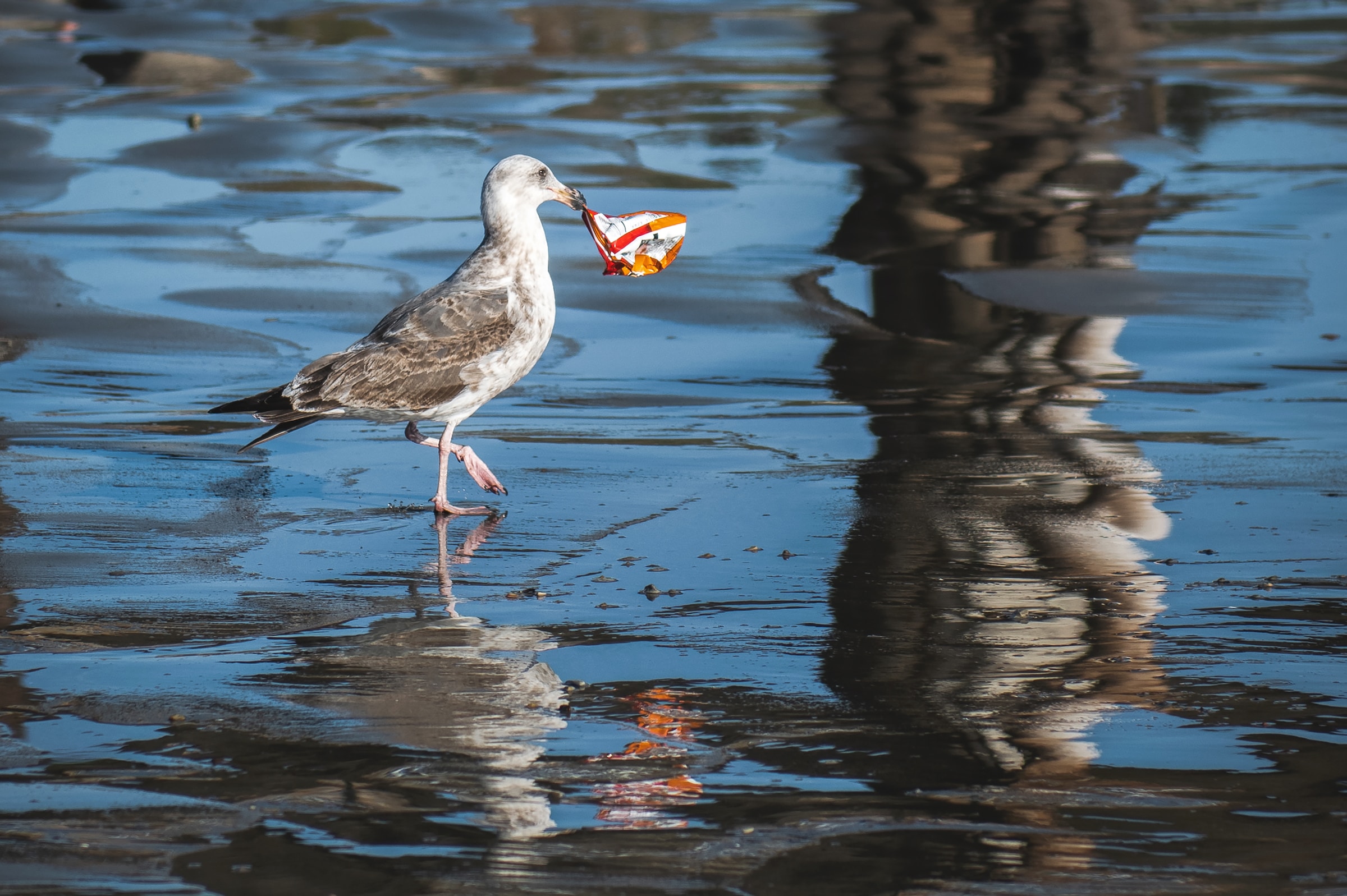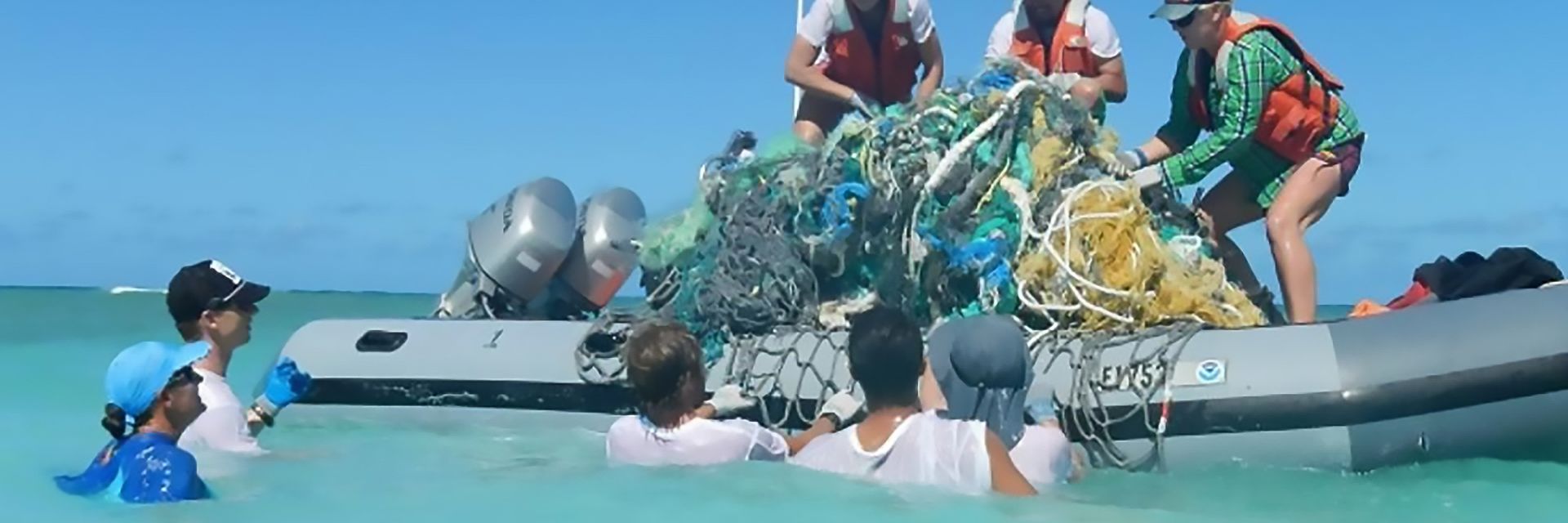Conservationists are alarmed by masses of floating plastic garbage that endanger our oceans, including one they have dubbed the “Great Pacific Garbage Patch.” Strategies for mitigating the threat posed by these patches are among the top priorities for oceanographers, marine biologists, and others concerned about the health of our oceans. When plastics get into the food chain, how can we ensure that they aren’t the “secret ingredient” in our fish and chips?
◊
The Peril of Plastics in the Oceans
Of all the pollutants threatening our endangered oceans, plastics are particularly noxious because, by their nature, they never truly disintegrate – they only break down into smaller and smaller pieces, called microplastics.
These microplastics cause damage to the natural order of ocean ecology in numerous ways, most notably in reduction of biodiversity and degradation of marine habitats. Because of the movement of ocean currents and prevailing winds, microplastics gather into massive fields of miniscule debris that float on or near the surface in many areas of the Pacific, Atlantic, and Indian oceans.
The largest masses of plastic garbage lie in the North Pacific Subtropical Gyre (NPSG), an area of approximately 7.7 million square miles in the central region of the Pacific Ocean where cooler water from the north mixes with warm water from the tropics. Because the waters at the center of the gyre tend to be calm, debris that circles and eventually reaches the center gets trapped there.
Debris vortexes, including the Great Pacific Garbage Patch, cover tens of thousands of square miles in the North Pacific Ocean.
.jpg)
Beach trash (Source: Justin Dolske, via Wikimedia Creative Commons)
The Great Pacific Garbage Patch (or Pepper in the Soup)
Within the NPSG, eastern and western garbage patches, or “debris vortexes,” cover tens of thousands of square miles. One such vortex is the Great Pacific Garbage Patch. The sources of the patch are many, but about 80 percent of the debris results from “land-based activities in North America and Asia.” The rest comes from marine activity like boating, offshore drilling, and sea-based industries such as shipping and fishing.
Contrary to the image its name might conjure in our minds, the Great Pacific Garbage Patch doesn’t look like a landfill floating on the surface of the ocean. In fact, despite the enormous area it covers, it can’t even be seen from satellites orbiting Earth. Because the plastic has broken down into billions of tiny pellets, one scientist describes them as resembling “flakes of pepper floating throughout a bowl of soup.” But certainly not a soup that any of us would find appetizing.
Plastic Pollution Endangers the Oceans’ Food Chain
The damage the debris vortexes do comes in many forms, including:
- Harming the growth cycle of plankton by forming a “sun shield” over them that prevents photosynthesis;
- Being mistaken for food by marine wildlife, causing death and damage to certain species; and
- Leaching poisonous polychlorinated biphenyls (PCBs) into the ocean food chain.
Each of these impacts has the potential to do serious harm to marine life; in combination, the damage can be catastrophic. The presence of plastic in our ocean waters endangers plankton and algae, the basic building blocks of the oceans’ chain of life. Microplastics block sunlight, limiting the ability of plankton and algae to access what they need to stay abundant and healthy.
Another important problem arises because the floating areas of microplastics form in what had been prime feeding sites for many species of marine life. But, because the waters of the garbage patches lack the nutrients to support those creatures, the vortexes have become vast “dead zones.”
In areas of the oceans that are not yet dead, the survival of fish may be threatened by the ingestion of plastic. It’s been noted that some fish have more plastic in their stomachs than natural food, and consumption of plastics that are mistaken for food may result in excessive mortality among already imperiled species.
Climbing Up The Food Chain (And Into Our Mouths!)
Indeed, the problem is not limited to fish. Other sea animals such as waterfowl, seals, and sea turtles are endangered by plastics. They can die from consuming the plastics or from entanglement in plastic refuse such as discarded plastic nets.
For example, loggerhead sea turtles often mistake plastic bags for jellyfish. To albatrosses, plastic resin pellets look like fish eggs, which they “harvest” to feed their chicks that then die of starvation or ruptured organs.
Farther up the food chain, some of the microplastics can even end up in the fish on our dinner tables. The pellets are so tiny that we can’t easily see, smell, or taste them, but we ingest them anyway – right along with the delicious seafood and seasonings. And what doesn’t pass through may lodge in our guts, along with toxic PCBs.
Plastics and other pollutants that don’t float, sink. Such waste coats the ocean floor under the patches. Oceanographers and ecologists have noted that about 70 percent of marine debris sinks to the bottom of the ocean.

Source: Tim Mossholder, via Unsplash
Ocean Conservation (And What You Can Do)
Taken together, the dangers presented by plastic in the oceans threaten to produce an ecological catastrophe as critical links in the entire marine food chain are disrupted or even severed. But what can be done?
Despite the existence of maritime law and oversight by international agencies, no country (or consortium of nations) has taken responsibility for the ever-growing presence of plastics that endanger our oceans. Nor is there a clear path toward its mitigation. Though challenges may seem intractable, there are ways forward, at least two of which appear potentially fruitful.
Some oceanographers are advocating an internationally binding agreement to establish so-called “Marine Protected Areas,” or MPAs. A worldwide network of MPAs, granted by treaty or other convention, would guarantee specific areas as protected, and all harvesting of these areas would be prohibited. This would allow for the eventual cleanup and restoration of natural flora and fauna native to the areas.
Like many ecological issues, the goal is easy to envision but hard to realize. We all must reduce our dependence on plastic and slow its flow into our oceans.
A more ambitious but perhaps simpler means of limiting the growth of plastic waste in the oceans would be an international agreement to police populated coastal areas to avert the continuing problem of trash being dumped – intentionally or accidentally – into the oceans. While this would not reduce the current levels of marine waste, it could be an important step in slowing the growth of by far the largest contributor to ocean garbage.
Simple Goal, Complex Strategies
Like many important, pressing ecological issues, the goal is easy to envision but hard to realize. In the starkest terms, we all – individuals and both land and sea-based industries – must substantially reduce our dependence on plastic, a material that simply will never fully disintegrate. We must also stop the relentless flow of plastic refuse into our endangered oceans – and ultimately back to our supper tables.
The goal will be difficult but not impossible to achieve. Through individual action and a sustained push by advocacy groups and nonprofits dedicated to healthy oceans, we may succeed in influencing both producers and users of plastics to recognize an undeniable truth: Water is our most precious resource, and restoring the Earth’s oceans must be an urgent priority if our planet is to survive as a viable home to countless species – including our own.
Ω
Kevin Martin is Senior Writer for MagellanTV. He writes on a wide variety of topics, including outer space, the fine arts, and modern history. He has had a long career as a journalist and communications specialist with both nonprofit and for-profit organizations. He resides in Glendale, California.
Title image: Marine Debris Removal ...Hawaiian Islands. (Credit: NOAA, via Wikimedia Commons)

